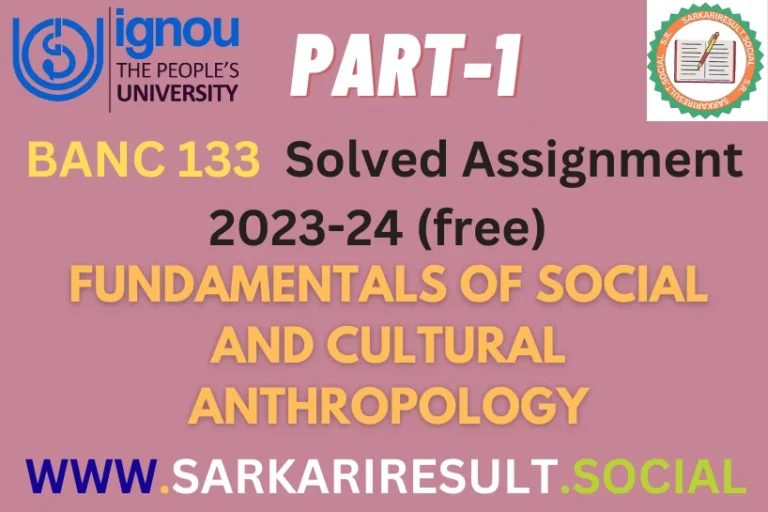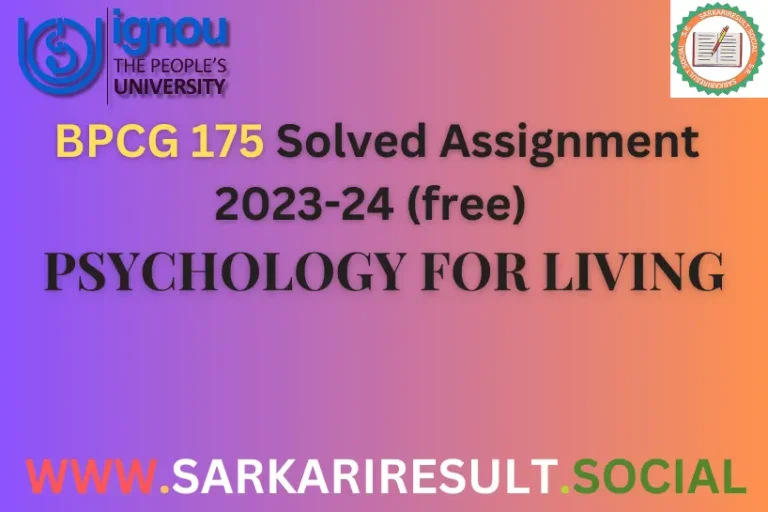Check BPCC-131 IGNOU Solved Assignment 2023 (free) in best quality
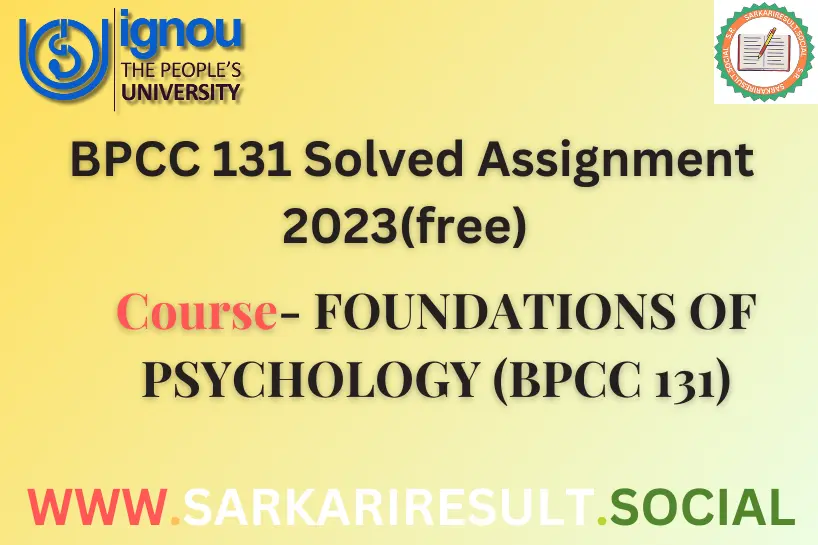
BPCC-131 IGNOU Solved Assignment 2023 (free)
Check out the best solved IGNOU Assignment of FOUNDATIONS OF PSYCHOLOGY (BPCC 131) BPCC-131. The Foundations of Psychology (BPCC 131) course offered by IGNOU (Assignments) for the Bachelor of Arts program delves into the mesmerizing realm of the human mind, providing a solid groundwork for understanding the intricacies of our thoughts, behaviors, and emotions.
Questions and Answers (Solved)
Assignment One of BPCC-131 IGNOU Solved Assignment 2023 (free)
Q.1 Discuss the main schools of thought that contributed to the development of psychology.
Ans. Psychology, as a field of study, has been shaped by various schools of thought that have contributed to its development over the years. These schools of thought represent different perspectives and approaches to understanding human behavior and mental processes. Let’s explore some of the main schools of thought in psychology.
1. Structuralism: This school of thought, led by Wilhelm Wundt, focused on breaking down mental experiences into their basic components. Structuralists aimed to understand the structure of consciousness through introspection, where individuals would analyze and describe their own thoughts and sensations.
2. Functionalism: Developed by William James, functionalism emphasized the purpose and function of human behavior. It sought to understand how our thoughts and behaviors help us adapt and function in our environment. Functionalists were interested in studying the practical uses of the mind and its impact on everyday life.
3. Behaviorism: Behaviorism, led by John B. Watson and later B.F. Skinner, focused on observable behavior rather than internal mental processes. Behaviorists believed that behavior could be studied objectively and explained by the principles of conditioning. They emphasized the role of learning and the influence of the environment on behavior.
4. Gestalt Psychology: Gestalt psychologists, including Max Wertheimer and Wolfgang Köhler, believed that our experiences should be viewed as a whole rather than the sum of individual parts. They argued that our perception of the world is not simply the result of adding up individual sensations, but rather a unique and organized experience.
5. Psychoanalysis: Developed by Sigmund Freud, psychoanalysis focused on the unconscious mind and the influence of early childhood experiences on behavior. Freud believed that many of our thoughts and behaviors are driven by unconscious desires and conflicts. Psychoanalysis aimed to bring these unconscious processes to awareness through techniques like dream analysis and free association.
6. Humanistic Psychology: Humanistic psychology, represented by thinkers like Carl Rogers and Abraham Maslow, emphasized the importance of personal growth, self-actualization, and subjective experiences. It focused on the individual’s capacity for personal choice and responsibility, emphasizing the importance of self-esteem and positive regard.
7. Cognitive Psychology: Cognitive psychology emerged as a response to behaviorism and focused on studying mental processes such as perception, memory, thinking, and problem-solving. Cognitive psychologists use experimental methods to understand how we acquire, process, and store information.
These are just a few of the major schools of thought that have shaped the field of psychology. Each school of thought offers a unique perspective and has contributed to our understanding of human behavior and the mind. It’s important to note that contemporary psychology is a combination of various approaches and incorporates insights from multiple schools of thought, leading to a more comprehensive understanding of human behavior.
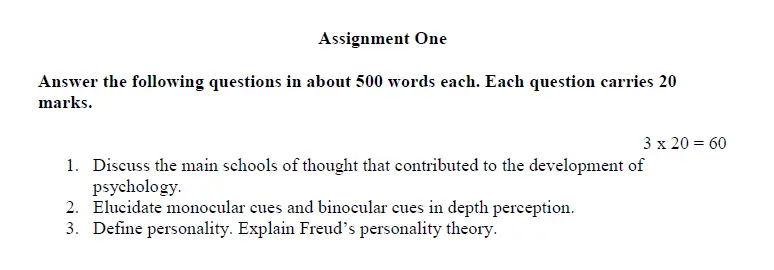
Q.2 Elucidate monocular cues and binocular cues in depth perception.
Ans. Depth perception refers to the ability to perceive the world in three dimensions and accurately judge the distances and spatial relationships between objects. Our brain utilizes various cues to create depth perception, including monocular cues and binocular cues. Let’s explore these cues in more detail.
Monocular cues are visual cues that can be perceived with only one eye. These cues provide important information about depth and distance and include:
1. Linear perspective: When parallel lines appear to converge as they recede into the distance, it creates a sense of depth. For example, the sides of a road seem to converge in the distance.
2. Relative size: When two objects are of similar size, we perceive the one that appears smaller as being farther away. For instance, if a person appears smaller than another person, we perceive them as being farther away.
3. Overlapping or interposition: When one object partially obstructs another, we perceive the obstructed object as being farther away. This cue helps us understand the spatial relationship between objects.
4. Texture gradient: Objects that are closer to us appear to have more distinct and detailed texture, while those farther away appear smoother and less detailed.
5. Motion parallax: When we are moving, objects closer to us appear to move faster than objects that are farther away. This cue helps us estimate the relative distance of objects based on their apparent motion.
Binocular cues, on the other hand, require both eyes and provide information about depth and distance by comparing the images received from each eye. The two primary binocular cues are:
1. Binocular disparity: Each eye receives a slightly different image due to the separation between them. The brain combines these images to create depth perception. By comparing the disparities between the two images, the brain can determine the relative distance of objects.
2. Convergence: When we focus on nearby objects, our eyes turn inward, causing the muscles to converge. The brain uses the level of convergence to estimate the distance of objects. Greater convergence indicates a closer object, while lesser convergence indicates a farther object.
Both monocular and binocular cues work together to provide us with a rich perception of depth and distance. Our brain seamlessly integrates these cues to create a three-dimensional understanding of the world around us.
It’s important to note that while these cues are generally reliable, they can sometimes be misleading. Optical illusions, for example, exploit these cues to create perceptual distortions. Additionally, individuals with vision impairments or certain eye conditions may have difficulty perceiving depth using these cues.
Understanding depth perception and the cues that contribute to it allows us to navigate the world accurately and safely. Scientists continue to study and explore these cues to gain further insights into how our brain processes visual information and perceives depth.
Also see : Check out IGNOU Assignment submission status 2023
Q.3 Define personality. Explain Freud’s personality theory.
Ans. Personality refers to the unique set of characteristics, behaviors, thoughts, and emotions that define an individual and distinguish them from others. It encompasses various traits and patterns of behavior that remain relatively stable over time and across different situations.
Sigmund Freud, a renowned psychologist, developed a theory of personality known as psychoanalytic theory. According to Freud, personality is composed of three main components: the id, ego, and superego. Let’s delve into each of these components:
1. Id: The id is the most primitive part of the personality and operates on the pleasure principle. It is present from birth and seeks immediate gratification of basic biological and instinctual needs, such as hunger and pleasure. The id is impulsive, irrational, and seeks instant gratification without considering the consequences.
2. Ego: The ego develops during early childhood and serves as the mediator between the id and the demands of reality. It operates on the reality principle and strives to find realistic and socially acceptable ways to satisfy the id’s desires. The ego considers the long-term consequences and tries to balance the conflicting demands of the id and superego.
3. Superego: The superego develops as a result of socialization and represents the moral standards and values of society. It is divided into two components: the ego ideal and the conscience. The ego ideal represents the idealized standards of behavior that individuals strive to achieve, while the conscience internalizes societal rules and punishes the ego with guilt for violating those rules.
Freud also proposed that personality is strongly influenced by three levels of consciousness:
1. Conscious: This level includes thoughts, feelings, and perceptions that we are aware of in the present moment.
2. Preconscious: The preconscious level consists of information that is not currently in conscious awareness but can be easily accessed and brought to conscious awareness when needed.
3. Unconscious: The unconscious level holds memories, desires, and experiences that are repressed or forgotten. Freud believed that the unconscious mind has a significant influence on our thoughts, feelings, and behavior, even though we are not consciously aware of it.
According to Freud, personality development occurs in stages:
1. Oral Stage (0-1 year): The focus of pleasure is on the mouth, such as sucking and biting.
2. Anal Stage (1-3 years): Pleasure is derived from bowel and bladder elimination, and children begin to develop control over these functions.
3. Phallic Stage (3-6 years): The focus of pleasure shifts to the genitals, and children develop unconscious sexual feelings for the opposite-sex parent, known as the Oedipus complex (for boys) or Electra complex (for girls).
4. Latency Stage (6-12 years): Sexual feelings are repressed, and children focus on developing social and intellectual skills.
5. Genital Stage (12 years and beyond): The individual’s sexual interests mature and become focused on intimate relationships.
Freud’s theory of personality has been influential, and his ideas have shaped the field of psychology. However, it is important to note that many of his concepts and theories have been criticized and revised by subsequent psychologists. Contemporary theories of personality consider a broader range of factors, such as genetics, social influences, and cognitive processes, in addition to unconscious motivations.
Assignment Two of BPCC-131 IGNOU Solved Assignment 2023 (free)
Q.4 Systematic Observation
Ans. Systematic observation is a method of gathering information about a specific topic or behavior by carefully and consistently observing and recording relevant details. It involves creating a structured plan to observe and document specific aspects of interest, such as behavior patterns, interactions, or environmental factors.
Systematic observation helps researchers or individuals gather objective data by following a predetermined set of guidelines. This method ensures that observations are consistent, reliable, and free from biases. By systematically observing and recording information, researchers can gain valuable insights into human behavior, animal behavior, or other phenomena of interest.
Also see : BPAG-171 Study Material Pdf free in English
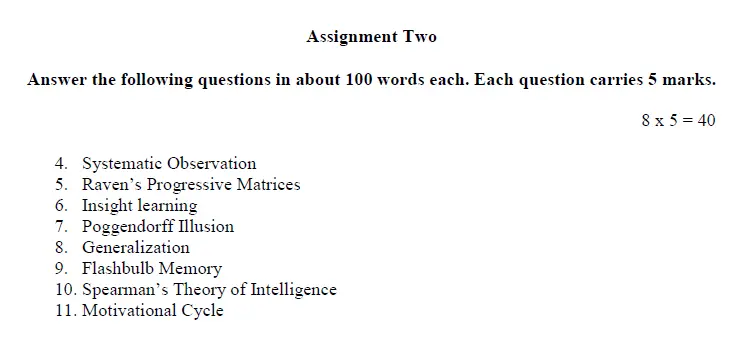
Q.5 Raven’s Progressive Matrices
Ans. Raven’s Progressive Matrices is a non-verbal test used to measure abstract reasoning and problem-solving skills. It consists of a series of visual patterns with a missing piece, and the task is to identify the missing piece from several options. The test assesses one’s ability to recognize patterns, make logical connections, and apply reasoning skills.
It is designed to measure cognitive abilities, including fluid intelligence and problem-solving abilities, independent of language or cultural background. Raven’s Progressive Matrices is widely used in educational and psychological settings to assess intellectual potential and cognitive abilities in individuals of various ages.
Q.6 Insight learning
Ans. Insight learning is a type of problem-solving where a sudden understanding or “aha” moment occurs. It involves gaining a deep understanding of a problem or situation without relying on trial and error or previous knowledge. In insight learning, the solution seems to come all at once, rather than through gradual steps.
This type of learning often involves reorganizing or restructuring our thinking to see the problem in a new light. Insight learning can be observed in various animals, including humans, and it highlights the importance of flexible thinking and creativity in problem-solving.
Q.7 Poggendorff Illusion
Ans. The Poggendorff illusion is a visual illusion that deceives our perception of the position of a line. It involves a diagonal line interrupted by a rectangular block, with two other lines intersecting the block. Even though the diagonal line appears to be aligned with the continuation of the interrupted line, it is actually misaligned.
This illusion occurs because our brain tends to perceive the interrupted line as continuing behind the rectangular block instead of being offset. The Poggendorff illusion demonstrates how our brain can be tricked by contextual cues, leading to misperception of spatial relationships in visual stimuli.
Also see : BPSC-131 IGNOU Solved Assignment 2023 (free)
Q.8 Generalization
Ans. Generalization refers to the process of applying knowledge or skills learned in one situation to similar situations. It involves recognizing similarities and commonalities between different situations and using past experiences to make predictions or draw conclusions in new contexts. For example, if you learn how to ride a bicycle, you can generalize that skill to ride different bicycles in various locations.
Generalization helps us transfer knowledge and skills from one context to another, saving time and effort in learning. However, it’s important to consider the differences between situations to avoid overgeneralization and ensure that the transferred knowledge is appropriate and accurate.
Q.9 Flashbulb Memory
Ans. Flashbulb memory refers to vivid and detailed memories of significant or emotionally charged events. It is as if a mental photograph is taken, capturing the event and its surrounding details. Flashbulb memories are often associated with surprising, highly emotional, or personally significant events like a natural disaster or a major life event.
People tend to have strong confidence in the accuracy of flashbulb memories, but research suggests they can be subject to distortions and errors over time. Although these memories feel vivid and real, they are not always completely accurate, highlighting the complexities of memory and how it can be influenced by emotions.
Q.10 Spearman’s Theory of Intelligence
Ans. Spearman’s theory of intelligence, also known as the two-factor theory, suggests that intelligence is composed of two components: general intelligence (g-factor) and specific abilities (s-factor). According to Spearman, the g-factor represents a person’s overall cognitive ability that underlies performance across different intellectual tasks.
The s-factor refers to specific abilities that are unique to particular tasks or domains. Spearman proposed that individuals who perform well in one intellectual area are likely to perform well in others, indicating a general underlying intelligence. His theory highlights the existence of a common factor influencing cognitive abilities while acknowledging the presence of specialized skills within specific areas.
Also see : BGDG 172 IGNOU solved assignment 2023
Q.11 Motivational Cycle
Ans. The motivational cycle is a process that describes how motivation influences behavior. It consists of four stages: needs, drives, behavior, and rewards. First, a need arises, such as hunger or thirst. This creates a drive, which is a state of internal tension that pushes us to satisfy the need.
The drive then leads to behavior, as we engage in actions to fulfill the need. Finally, when the need is satisfied, we receive rewards, such as food or water, which reduce the drive and provide a sense of satisfaction. The motivational cycle highlights how our needs drive our behavior and how rewards reinforce our motivation to satisfy those needs.

